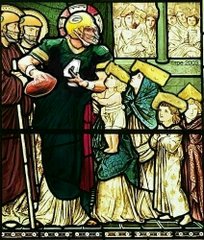Until the Last Day, or at least until our last day of death to this world of flesh, Baptized believers groan "in the pains of childbirth" as we are being born again into the kingdom of heaven. We are very much like the infant in utero--dependent on our mother for nourishment and protection. And like the infant in utero, we are also at the most dangerous stage of life, with the highest mortality rate.
God in His infinite wisdom and great compassion does not simply create a believer and drop him into this world of sin, death, and evil to fend for himself until the day of Resurrection. While we wait for that day of "the redemption of our bodies," God keeps us secure in the womb of the Church surrounded by the water of life flowing from the font of Holy Baptism.
The amniotic fluid in a pregnant mother's womb not only protects her baby. It is the very medium in which the baby lives and moves and has its being. The baby is nourished, gets its breath, and has impurities eliminated through the amniotic fluid.
This is also the way it is for the believer by the water "connected with God's Word" in Holy Baptism. [See Part I of Luther's Small Catechism explanation of the Sacrament of Holy Baptism quoted in the following paragraph.] Just as a baby in utero is compromised by insufficient amniotic fluid--indeed will die without the proper balance of electrolytes, proteins, carbohydrates, fats, and even urea--the believer also must continue to be fed, given breath, and cleansed of the impurity of sin by the Word of Baptism in the name of the Father, and of the + Son, and of the Holy Spirit that surrounds him in the womb of Christ's bride.
As we learn from Part I of Luther's Small Catechism explanation of the Sacrament of Holy Baptism:
“Baptism is not simple water only, but it is the water comprehended in God's command and connected with God's Word. As Christ, our Lord, says in the last chapter of Matthew: ‘Go ye into all the world and teach all nations, baptizing them in the name of the Father, and of the Son, and of the Holy Ghost.’
In the very next verse, our Lord continues His thought and command. "Teaching them to observe all things whatsoever I have commanded you:" Matthew 28:20. The period the King James Version places between verses nineteen and twenty does not exist in the original Greek, and is not indicated by the words of the sentence themselves. In fact, that the first word of verse twenty, "teaching," takes the same participial form as "baptizing" indicates that the two clauses go together as translated by the New International Version and the English Standard Version. In fact, they must in order to have a proper grammatical sentence.
Jesus--the Son and Christ and very Word of God Himself—here tells us that teaching everything that He has spoken and revealed to man as recorded in Holy Scripture is connected with Baptism along with the holy name of God. Regardless of the amount of the earthly element of water used, in Holy Baptism we are immersed in the name and Word of God, which forgives sins and by which we are born again from above into the kingdom of heaven.
And, as Christ’s apostle Peter boldly proclaims, this Baptism into the water and Word of Christ’s holy bride, the Church, “now saves you” 1Peter 3:21.







No comments:
Post a Comment